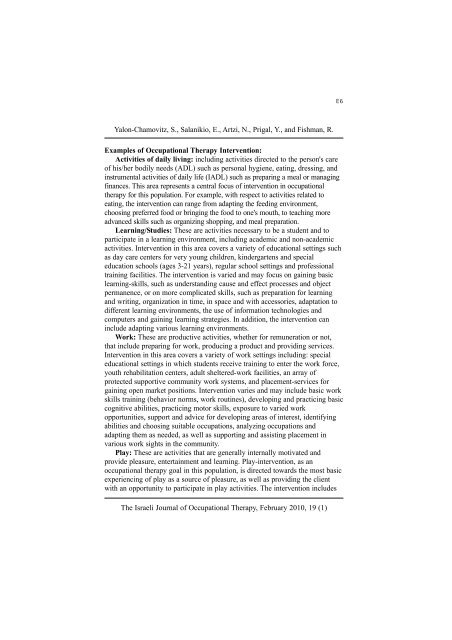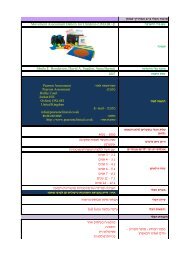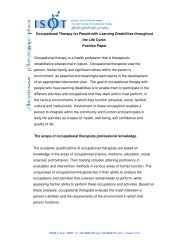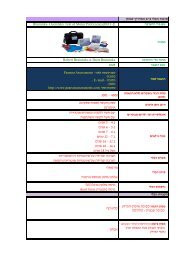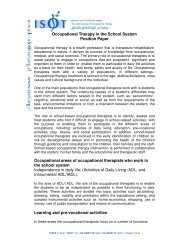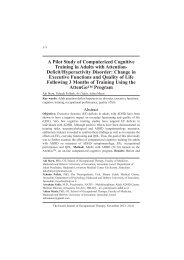Occupational Therapy and Intellectual and Developmental Disability ...
Occupational Therapy and Intellectual and Developmental Disability ...
Occupational Therapy and Intellectual and Developmental Disability ...
Create successful ePaper yourself
Turn your PDF publications into a flip-book with our unique Google optimized e-Paper software.
E6<br />
Yalon-Chamovitz, S., Salanikio, E., Artzi, N., Prigal, Y., <strong>and</strong> Fishman, R.<br />
Examples of <strong>Occupational</strong> <strong>Therapy</strong> Intervention:<br />
Activities of daily living: including activities directed to the person's care<br />
of his/her bodily needs (ADL) such as personal hygiene, eating, dressing, <strong>and</strong><br />
instrumental activities of daily life (IADL) such as preparing a meal or managing<br />
finances. This area represents a central focus of intervention in occupational<br />
therapy for this population. For example, with respect to activities related to<br />
eating, the intervention can range from adapting the feeding environment,<br />
choosing preferred food or bringing the food to one's mouth, to teaching more<br />
advanced skills such as organizing shopping, <strong>and</strong> meal preparation.<br />
Learning/Studies: These are activities necessary to be a student <strong>and</strong> to<br />
participate in a learning environment, including academic <strong>and</strong> non-academic<br />
activities. Intervention in this area covers a variety of educational settings such<br />
as day care centers for very young children, kindergartens <strong>and</strong> special<br />
education schools (ages 3-21 years), regular school settings <strong>and</strong> professional<br />
training facilities. The intervention is varied <strong>and</strong> may focus on gaining basic<br />
learning-skills, such as underst<strong>and</strong>ing cause <strong>and</strong> effect processes <strong>and</strong> object<br />
permanence, or on more complicated skills, such as preparation for learning<br />
<strong>and</strong> writing, organization in time, in space <strong>and</strong> with accessories, adaptation to<br />
different learning environments, the use of information technologies <strong>and</strong><br />
computers <strong>and</strong> gaining learning strategies. In addition, the intervention can<br />
include adapting various learning environments.<br />
Work: These are productive activities, whether for remuneration or not,<br />
that include preparing for work, producing a product <strong>and</strong> providing services.<br />
Intervention in this area covers a variety of work settings including: special<br />
educational settings in which students receive training to enter the work force,<br />
youth rehabilitation centers, adult sheltered-work facilities, an array of<br />
protected supportive community work systems, <strong>and</strong> placement-services for<br />
gaining open market positions. Intervention varies <strong>and</strong> may include basic work<br />
skills training (behavior norms, work routines), developing <strong>and</strong> practicing basic<br />
cognitive abilities, practicing motor skills, exposure to varied work<br />
opportunities, support <strong>and</strong> advice for developing areas of interest, identifying<br />
abilities <strong>and</strong> choosing suitable occupations, analyzing occupations <strong>and</strong><br />
adapting them as needed, as well as supporting <strong>and</strong> assisting placement in<br />
various work sights in the community.<br />
Play: These are activities that are generally internally motivated <strong>and</strong><br />
provide pleasure, entertainment <strong>and</strong> learning. Play-intervention, as an<br />
occupational therapy goal in this population, is directed towards the most basic<br />
experiencing of play as a source of pleasure, as well as providing the client<br />
with an opportunity to participate in play activities. The intervention includes<br />
The Israeli Journal of <strong>Occupational</strong> <strong>Therapy</strong>, February 2010, 19 (1)


